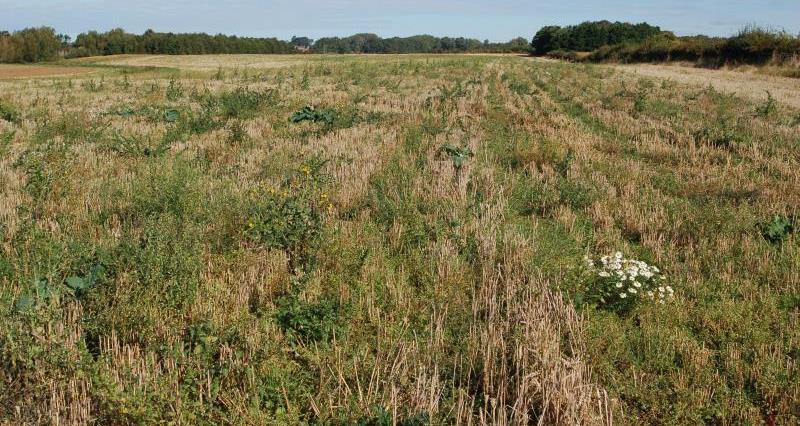What
Retain over-wintered stubbles (not maize stubbles) that have not received a pre-harvest desiccant through to at least mid-February. It is estimated that over-wintered stubbles on at least 10% of the cropped area will provide sufficient food to improve winter survival of seed-eating birds.
Why
- Leaving stubbles is an easy way to help wildlife if you still have spring crops in your rotation.
- Lack of winter seed food is the main cause of declines of some farmland birds.
- Retaining over-wintered stubbles is the easiest way to feed seed-eating birds on arable farms where spring crops are still used.
- Spilt grain and the seeds of broad-leaved weeds are vital for the winter survival of many seed-eating birds.
- Species that will benefit include grey partridge (and other game birds), skylark, tree sparrow, linnet, yellowhammer, reed bunting and corn bunting.
- Over-wintered stubble followed by a spring crop is also an important habitat for brown hares. The arable weeds most beneficial to birds are generally not the highly competitive grass weeds or cleavers, but species such as chickweed, fat-hen, charlock, knotgrass and annual meadow grass.
- Spring crops following the over-wintered stubble can provide nesting habitat for lapwings (if established in February or March) and skylarks, and are particularly beneficial feeding habitats for brown hares, grey partridges, turtle doves, tree sparrows, linnets and buntings.
- Retaining the stubble after harvest can allow important arable plants to set seed. The following spring crop can support rare spring-germinating arable plants.
The ‘Hungry Gap’
Seed-eating birds generally experience a glut of food in the autumn immediately after harvest, but struggle increasingly to find food as stubbles are cultivated and other seed sources become depleted until new seed sources become available in the following spring.
The hungry gap can start any time from Christmas, depending on the amount of seed-rich habitats in the area, and lasts until May. Even where stubbles are retained until mid-February and seed mixtures are grown to provide seed food, a hungry gap between February and May remains and can be difficult to fill.
Any areas of stubble retained through the spring as natural regeneration, or biennial seed mixtures left unharvested through the second spring, can provide some seed food. Supplementary feeding of spare grains (for buntings and game birds) and oilseeds (for finches) in cover crops and farmland bird feeding stations are the most reliable means of providing late winter food.
How
- Cereal stubbles (not maize), especially those of barley and spring-sown cereals are the most beneficial for wildlife through the winter. No pre-harvest desiccant in the preceding crop increases the value of the over-wintered stubble for wildlife significantly.
- If the tramlines run down the slope and this is steeper than 3 then they may act as channels for soil erosion or run-off over the winter. This can be prevented by sub-soiling the tramlines to allow water to soak into the soil, rather than staying on a compacted surface and running down the tramlines.
- The weed seed available will largely be that produced by weeds that germinated with the preceding crop. Limited herbicide use or conservation headlands in the preceding crop, therefore, will greatly enhance the stubble's benefit to seed-eating birds.
- The best stubbles for wildlife receive no herbicides, fertiliser or liming materials from before harvest and at least mid-February.
- The stubble of undersown crops is less beneficial for seed-eating birds, as the grass crop will hide the seeds on the ground. However, undersown crops are good for insects such as sawflies, which are important food for grey partridge chicks.
- A variety of stubble heights around the farm will provide benefits for the widest range of species.
- If you have areas with severe infestations of blackgrass, it may be worth taking them out of cropping for a year, allowing natural regeneration of the stubble through the winter and spring and spraying with a total herbicide after 15 May. This will have both agronomic and wildlife benefits.
